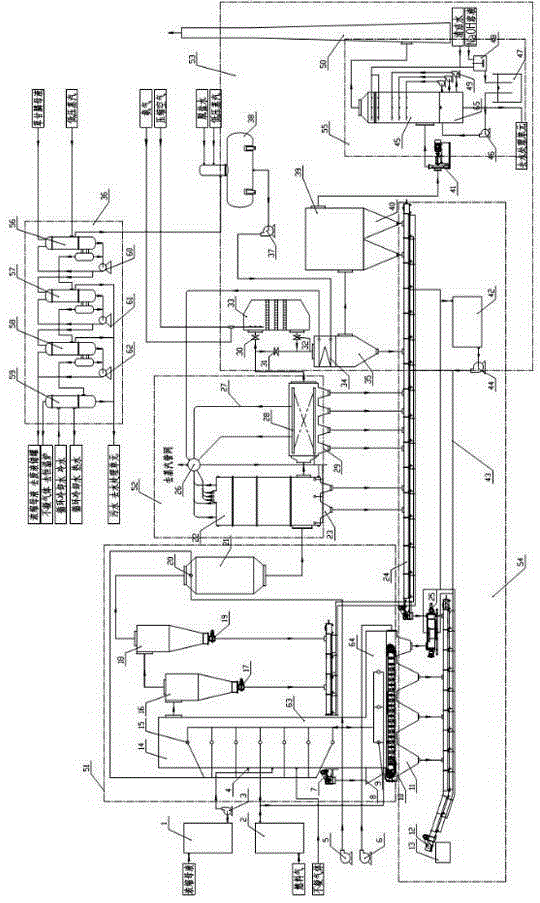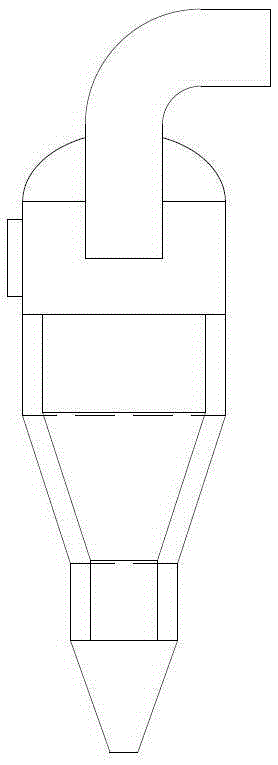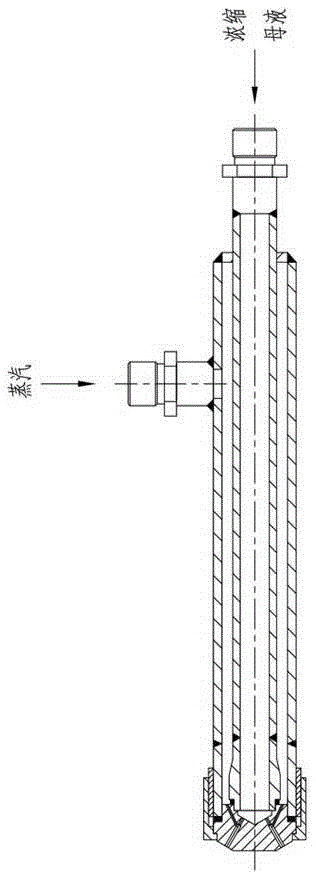However, the two-stage
incineration device and
incineration system described in this patent has the following disadvantages: (1) The outlet of the vertical furnace is directly connected to the secondary
combustion settling chamber, and a large amount of salt-containing solid particles carried in the
flue gas are heated again, making it When it becomes molten, the settled
molten salt-containing solid particles will block the
slag discharge hole of the secondary
combustion settling chamber, and the
molten salt-containing solid particles brought into the heat exchange unit will stick to the heat exchange tube, resulting in The
thermal efficiency is reduced, and even the
flue gas channel is blocked; (2) The front of the scale circulating grate is equipped with a hopper, which cannot return the unburned solid particles containing salt to the horizontal furnace for further
incineration. The impurities of chemical raw materials produced during the incineration process (3) The waste liquid atomizing spray gun is a two-fluid structure atomizing gun, and the outer layer is a
compressed air pipeline. According to experience, the glyphosate mother liquor has a high
viscosity at
room temperature, and it needs to be heated to reduce its
viscosity coefficient, while
compressed air is mostly At
room temperature, using
compressed air as the atomization medium will cool the glyphosate mother liquor, the
viscosity coefficient will increase, the
nozzle will be blocked, and the atomization effect will be affected, and the atomization effect is an important factor affecting the
combustion efficiency; (4) vertical furnace , The horizontal furnace and the secondary combustion
settling chamber do not limit the incineration temperature. From the collection of solid materials, it can be seen that although it is two-stage combustion, it is basically low-temperature combustion, and the
organic matter in the waste liquid cannot be completely incinerated. It also cannot meet the national "
Pollution Control Standards for
Hazardous Waste Incineration"; (5) The glyphosate mother liquor sprayed into the vertical furnace through the waste liquid atomization spray gun has not been concentrated, and the glyphosate mother liquor contains a large amount of water, which makes this A large amount of auxiliary fuel is consumed for part of the water to reach the combustion temperature of the furnace, resulting in a waste of energy
However, the method and device for producing
sodium pyrophosphate by constant-temperature
calcination of glyphosate mother liquor described in this patent has the following disadvantages: (1) The three inlets of the incinerator are respectively glyphosate mother liquor pipeline and combustion air from bottom to top Pipelines and
natural gas pipelines are all supplied in a centralized manner, and the combustion area is relatively concentrated, resulting in excessive local temperature, which will generate more thermal
NOx, and there is no
denitrification device at the rear, and the
environmental protection is not up to standard; (2) The three parts of the incinerator The two inlets from bottom to top are glyphosate mother liquor pipeline, combustion air pipeline and
natural gas pipeline, all of which are supplied in a centralized manner, and the combustion area is relatively concentrated, resulting in excessive local temperature and uneven temperature field, so that the glyphosate mother liquor cannot Complete combustion, there are organic residues on the surface of
sodium pyrophosphate solid particles, and the purity of
sodium pyrophosphate is low; (3) The glyphosate mother liquor is directly sprayed into the furnace through a
booster pump, and the droplet
diameter is relatively large, so the
evaporation of the glyphosate mother liquor, The
decomposition and oxidation time will increase correspondingly, which is not conducive to the complete incineration of glyphosate mother liquor; (4) The salt produced during the
combustion process in the incinerator will settle under the action of gravity and then sent to the
slag remover, because the salt produced during the
combustion process If it is in a
molten state, it will stick to the internal transmission device of the
slag remover when it enters the slag remover, which will eventually cause the blockage of the slag remover; (5) There are two combustion chambers in the incinerator, and the
reaction temperature in the second
combustion chamber is controlled at 900 ~ At 1000°C, the
molten salt enters the
cyclone dust collector along with the
flue gas, and the molten salt will bond along the circumferential direction of the
cyclone dust collector, eventually blocking the
cyclone dust collector; Ideally, unseparated molten salt is likely to block the rear heating surface and flue; (7) The glyphosate mother liquor sprayed into the vertical furnace through the waste liquid atomization spray gun has not been concentrated, and the glyphosate mother liquor contains A large amount of water, so that this part of water reaches the combustion temperature of the furnace needs to consume a large amount of auxiliary fuel, resulting in a waste of energy; (8) There are 3 cooling chambers in the
waste heat boiler, and the cooling chambers are generally cavities surrounded by membrane water walls Type heating surface, mainly based on
radiation heat transfer, the
heat transfer effect is good when the flue gas temperature is high, and the
heat transfer effect is not good when the flue gas temperature is low, it is necessary to increase the heating surface to reduce the flue gas temperature, which increases the initial
investment cost of the equipment; (9) The induced draft fan is arranged after the
water washing spray tower, which increases the load of the induced draft fan and increases the
power consumption Login to View More
Login to View More  Login to View More
Login to View More 


